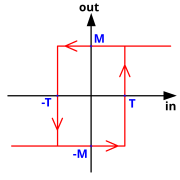
Back Тригер на Шмит Bulgarian Schmitt trigger Catalan Schmittův klopný obvod Czech Schmitt-trigger Danish Schmitt-Trigger German Disparador Schmitt Spanish Schmitti lülitus Estonian Disparaol schmitt EXT اشمیت تریگر Persian Schmitt-liipaisin Finnish
This article needs additional citations for verification. (March 2021) |

In electronics, a Schmitt trigger is a comparator circuit with hysteresis implemented by applying positive feedback to the noninverting input of a comparator or differential amplifier. It is an active circuit which converts an analog input signal to a digital output signal. The circuit is named a trigger because the output retains its value until the input changes sufficiently to trigger a change. In the non-inverting configuration, when the input is higher than a chosen threshold, the output is high. When the input is below a different (lower) chosen threshold the output is low, and when the input is between the two levels the output retains its value. This dual threshold action is called hysteresis and implies that the Schmitt trigger possesses memory and can act as a bistable multivibrator (latch or flip-flop). There is a close relation between the two kinds of circuits: a Schmitt trigger can be converted into a latch and a latch can be converted into a Schmitt trigger.
Schmitt trigger devices are typically used in signal conditioning applications to remove noise from signals used in digital circuits, particularly mechanical contact bounce in switches. They are also used in closed loop negative feedback configurations to implement relaxation oscillators, used in function generators and switching power supplies.

In signal theory, a schmitt trigger is essentially a one-bit quantizer.
© MMXXIII Rich X Search. We shall prevail. All rights reserved. Rich X Search